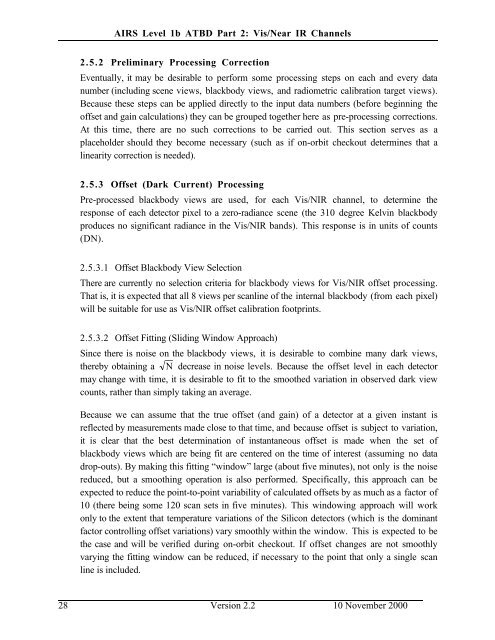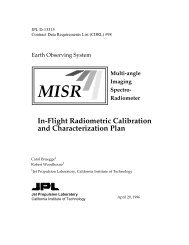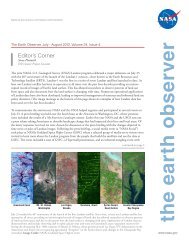AIRS Level 1B Visible/Near-Infrared Channels ATBD - NASA's Earth ...
AIRS Level 1B Visible/Near-Infrared Channels ATBD - NASA's Earth ...
AIRS Level 1B Visible/Near-Infrared Channels ATBD - NASA's Earth ...
Create successful ePaper yourself
Turn your PDF publications into a flip-book with our unique Google optimized e-Paper software.
<strong>AIRS</strong> <strong>Level</strong> 1b <strong>ATBD</strong> Part 2: Vis/<strong>Near</strong> IR <strong>Channels</strong><br />
2.5.2 Preliminary Processing Correction<br />
Eventually, it may be desirable to perform some processing steps on each and every data<br />
number (including scene views, blackbody views, and radiometric calibration target views).<br />
Because these steps can be applied directly to the input data numbers (before beginning the<br />
offset and gain calculations) they can be grouped together here as pre-processing corrections.<br />
At this time, there are no such corrections to be carried out. This section serves as a<br />
placeholder should they become necessary (such as if on-orbit checkout determines that a<br />
linearity correction is needed).<br />
2.5.3 Offset (Dark Current) Processing<br />
Pre-processed blackbody views are used, for each Vis/NIR channel, to determine the<br />
response of each detector pixel to a zero-radiance scene (the 310 degree Kelvin blackbody<br />
produces no significant radiance in the Vis/NIR bands). This response is in units of counts<br />
(DN).<br />
2.5.3.1 Offset Blackbody View Selection<br />
There are currently no selection criteria for blackbody views for Vis/NIR offset processing.<br />
That is, it is expected that all 8 views per scanline of the internal blackbody (from each pixel)<br />
will be suitable for use as Vis/NIR offset calibration footprints.<br />
2.5.3.2 Offset Fitting (Sliding Window Approach)<br />
Since there is noise on the blackbody views, it is desirable to combine many dark views,<br />
thereby obtaining a N decrease in noise levels. Because the offset level in each detector<br />
may change with time, it is desirable to fit to the smoothed variation in observed dark view<br />
counts, rather than simply taking an average.<br />
Because we can assume that the true offset (and gain) of a detector at a given instant is<br />
reflected by measurements made close to that time, and because offset is subject to variation,<br />
it is clear that the best determination of instantaneous offset is made when the set of<br />
blackbody views which are being fit are centered on the time of interest (assuming no data<br />
drop-outs). By making this fitting “window” large (about five minutes), not only is the noise<br />
reduced, but a smoothing operation is also performed. Specifically, this approach can be<br />
expected to reduce the point-to-point variability of calculated offsets by as much as a factor of<br />
10 (there being some 120 scan sets in five minutes). This windowing approach will work<br />
only to the extent that temperature variations of the Silicon detectors (which is the dominant<br />
factor controlling offset variations) vary smoothly within the window. This is expected to be<br />
the case and will be verified during on-orbit checkout. If offset changes are not smoothly<br />
varying the fitting window can be reduced, if necessary to the point that only a single scan<br />
line is included.<br />
28 Version 2.2 10 November 2000







